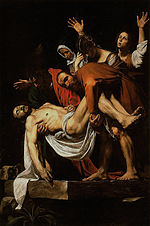| Part of a series on |
| Death and Resurrection of Jesus |
|---|
 |
|
Portals: |
The instrument of Jesus' crucifixion (known in Latin as crux, in Greek as stauros) is generally taken to have been composed of an upright wooden beam to which was added a transom, thus forming a "cruciform" or T-shaped structure.
Most Christian denominations present the Christian cross in this form, and the tradition of the T-shape can be traced to early Christianity and the Church fathers. Nonetheless, some late-19th century scholars maintained that it was a simple stake (crux simplex). In 2011 Gunnar Samuelsson concluded that there is not enough evidence in pre-Christian ancient texts or in the New Testament writings themselves to resolve the ambiguity of the terms referring to the instrument on which Jesus was executed.[1] On the other hand, David W Chapman argues that to take one single Greek word and conclude that it has one universal and unchanging meaning like the word stauros "is a common word study fallacy in some populist literature. In fact, such terminology often referred in antiquity to cross-shaped crucifixion devices. For example, Lucian, in a brief dialogue that employs most Greek crucifixion vocabulary, refers to the "crucifixion" of Prometheus, whose arms are pinned while stretched from one rock to another. Such a cross-shaped crucifixion position in the Roman era may actually have been the norm."[2]
- ^ Gunnar Samuelsson, Crucifixion in Antiquity (Mohr Siebeck 2013 ISBN 978-3-16-152508-7), p. 303
- ^ Chapman, David W. Ancient Jewish and Christian Perceptions of Crucifixion. Mohr Siebeck, 2008. p. 11.